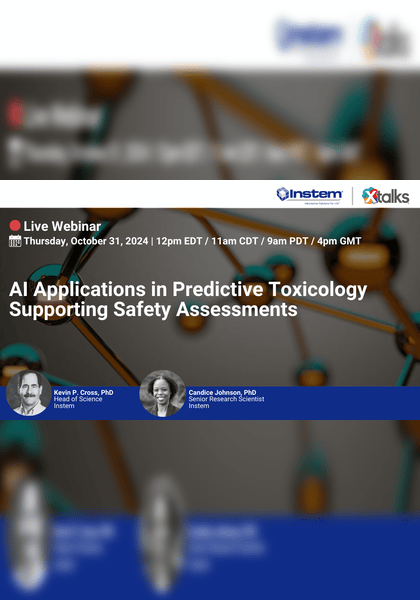
The application of artificial intelligence (AI) technologies, such as machine learning models (e.g., QSAR) and expert rules-based systems, is a well-established practice in regulatory predictive toxicology, where they are used to support drug safety assessments.
The implementation of these methods in regulatory predictive toxicology is partly due to their adherence to principles defined in the OECD QSAR Assessment Framework (QAF) that outline criteria (based on earlier validation principles for models) to help ensure data quality, objective measures of QSAR model performance and robustness, a domain of applicability, documentation, transparency, and an underlying mechanistic interpretation where possible.
Recently, advancements in technology, such as algorithmic innovation, have led to a surge in new AI modalities. New guidelines need to be developed to ensure data reliability for models to be suitable to support regulatory assessments. In this webinar, the expert speakers will illustrate how Leadscope’s QSAR models and structural alerts adhere to the QAF and support regulatory safety assessments. They will identify current and emerging regulatory guidelines and demonstrate the applicability of structure-based predictive models.
Regulatory interest in the use of QSARs to support drug safety assessments began in the 1990s. The evaluation of DNA-reactive (mutagenic) impurities in pharmaceuticals, as outlined in the ICH M7 guideline published in 2014, currently represents the most prevalent application of QSARs in predictive toxicology for regulatory purposes. It is valuable to examine the factors contributing to the successful adoption of QSARs in this context. Leadscope’s bacterial mutation consensus model of the Ames assay was developed by several key steps: curating data from trusted sources, normalizing chemical structures, determining model domain, validating performance externally and ensuring transparency and interpretability of chemical descriptors and predictions, supported by mechanistic and statistical evidence. Scientific understanding is important for refining and developing regulatory models and methodologies. For example, insights into the α-hydroxylation metabolic activation pathway led to the development of the carcinogenic potency categorization approach (CPCA) in 2024, which estimates acceptable intake limits for N-nitrosamines drug substance-related impurities (NDSRIs).
In 2020, the US Food and Drug Administration (FDA) published guidance on evaluating drug-drug interactions (DDI), discussing the use of structural features to determine the need for in vitro studies to assess cytochrome P450 (CYP) inhibition by potential metabolites. Assessing DDI is crucial as CYP enzyme inhibition or induction can alter co-administered drug activity, potentially causing adverse effects and market withdrawal. The expert speakers will examine DDI mechanisms and the use of QSARs to predict reversible and irreversible CYP inhibition as well as bioactivation alerts.
The regulatory interest in structure-based machine learning methods continues to increase. Emerging guidelines such as the ICH Q3E may provide additional insight on, if or how existing SAR knowledge could be used to conduct a safety assessment for extractables and leachables. Additionally, the demonstrated fitness for the purpose of acute oral toxicity models has triggered discussions on their applicability in regulatory contexts.
Register for this webinar today to explore the application of advanced AI technologies such as QSAR models and expert rules-based systems in supporting drug safety assessments.
Keywords: ADME, Drug Development, Drug Discovery, Pharmacovigilance, Regulatory, Translational Research, Toxicology/Safety, Extractables & Leachables
